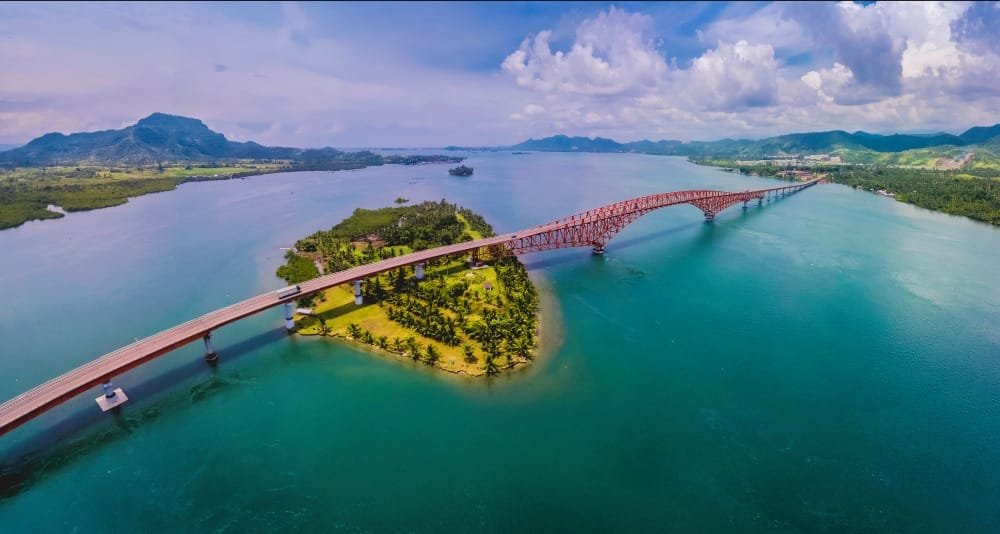Samar faced a fuel supply disruption as new restrictions on the San Juanico Bridge blocked the passage of heavy vehicles—including fuel tankers. The Department of Public Works and Highways (DPWH) recently imposed a strict 3-metric ton weight limit on the 2.16-kilometer span, effectively halting all land-based fuel deliveries to the island.
This sudden limitation is a logistical blow for Samar, where petroleum transport has long depended on tankers crossing the bridge from Leyte. Standard fuel tankers, carrying around 10,000 liters, weigh nearly 20 metric tons—far beyond the newly enforced limit.
The weight restriction, implemented on May 8, stems from safety concerns about the aging bridge structure. While necessary, the move has disrupted the island’s fuel lifeline, sparking concern among local stakeholders over potential shortages.
By the end of May, as the restrictions entered their third week, Samar had already begun to feel the strain. Governor Sharee Ann Tan reported signs of tightening fuel supply across the island.
Most gas stations, she noted, had storage capacity for just one to two weeks’ worth of fuel, requiring frequent replenishment.
(Also read: Negros Occidental Seals P158-M Deal for Solar Power in Government Facilities)
Multi-agency strategy needed
The Department of Energy (DoE) had promised Samar that the fuel supply would remain steady despite ongoing repairs to the aging San Juanico Bridge.
In a statement, the agency said it was working closely with other government bodies and fuel industry players to resolve delivery challenges and keep petroleum flowing into the province.
To ease Samar’s fuel woes, the DoE secured approval from the National Disaster Risk Reduction and Management Council (NDRRMC) to prioritize oil tankers in RoRo vessel loading lines.
With land routes blocked, tankers are now being rerouted via the Ormoc-to-Calbayog sea corridor—an alternative that takes at least 12 hours and has already seen mounting congestion.
In coordination with the Petroleum Institute of the Philippines (PIP), the DoE began scheduling fuel deliveries through Ormoc Port beginning May 29.
DoE Secretary Raphael Lotilla reaffirmed the agency’s commitment to ensuring Samar’s energy security. “By working hand-in-hand with government agencies and oil industry partners, we are confident in our shared ability to rise above these challenges with unity, urgency and purpose,” he stated.
(Also read: Securing the Visayas Grid: The Vital Role of Baseload Power)
DoE’s acknowledgement
The DoE expressed gratitude to national and local agencies, along with private oil firms, for their swift coordination in maintaining steady fuel and LPG deliveries to Samar.
Private sector support came in the form of Insular Oil Corporation, which stepped in to bolster Samar’s fuel security. The local petroleum firm, operating a storage facility in San Isidro, Northern Samar, agreed to receive deliveries from both major oil firms and independent suppliers. This move added a critical buffer to the region’s supply chain, helping ease pressure as logistics were rerouted.
The DOE highlighted its commitment to long-term energy resilience by vowing to maintain close coordination with government agencies, fuel industry players, and private partners. Ongoing discussions aim to streamline fuel logistics, improve port operations, and align delivery schedules to ensure a steady and secure flow of petroleum products.
Reliable fuel access, the department noted, remains vital—not just for daily transportation and commerce, but also for supporting emergency services and disaster response efforts across the region.
Sources:
https://www.bworldonline.com/the-nation/2025/05/27/675336/doe-fuel-supply-to-samar-to-continue/
https://pia.gov.ph/fueling-samar-navigating-petroleum-supply-amid-bridge-restrictions


